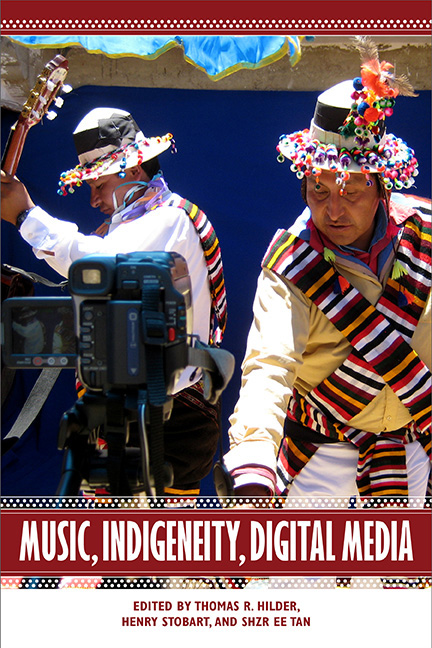Book contents
- Frontmatter
- Dedication
- Contents
- List of Illustrations
- Acknowledgments
- Music, Indigeneity, Digital Media: An Introduction
- 1 Taiwan's Aboriginal Music on the Internet
- 2 Recording Technology, Traditioning, and Urban American Indian Powwow Performance
- 3 YouTubing the “Other”: Lima's Upper Classes and Andean Imaginaries
- 4 An Interview with Russell Wallace
- 5 Mixing It Up: A Comparative Approach to Sámi Audio Production
- 6 Creative Pragmatism: Competency and Aesthetics in Bolivian Indigenous Music Video (VCD) Production
- 7 Keepsakes and Surrogates: Hijacking Music Technology at Wadeye (Northwest Australia)
- 8 The Politics of Virtuality: Sámi Cultural Simulation through Digital Musical Media
- Selected Bibliography
- List of Contributors
- Index
6 - Creative Pragmatism: Competency and Aesthetics in Bolivian Indigenous Music Video (VCD) Production
Published online by Cambridge University Press: 26 April 2018
- Frontmatter
- Dedication
- Contents
- List of Illustrations
- Acknowledgments
- Music, Indigeneity, Digital Media: An Introduction
- 1 Taiwan's Aboriginal Music on the Internet
- 2 Recording Technology, Traditioning, and Urban American Indian Powwow Performance
- 3 YouTubing the “Other”: Lima's Upper Classes and Andean Imaginaries
- 4 An Interview with Russell Wallace
- 5 Mixing It Up: A Comparative Approach to Sámi Audio Production
- 6 Creative Pragmatism: Competency and Aesthetics in Bolivian Indigenous Music Video (VCD) Production
- 7 Keepsakes and Surrogates: Hijacking Music Technology at Wadeye (Northwest Australia)
- 8 The Politics of Virtuality: Sámi Cultural Simulation through Digital Musical Media
- Selected Bibliography
- List of Contributors
- Index
Summary
Although several of the case stswudies in this book feature indigenous people based in countries with strong economies, it is important to stress that a disproportionate number of the world's indigenous people live in poverty. A particularly notable aspect of the so-called digital revolution is the way it has provided low-income consumers and creators with access to cheap audio-visual technologies. Massive reductions in prices alongside exponential growth in unlicensed copying (so-called media piracy) have given rise to an abundance of new media consumers and producers among the world's poorer populations, especially in parts of the global south. In such regions, the Internet is often available only in larger towns and cities, primarily accessed in public Internet cafes. In these rapidly transforming technological environments, the number of home computers has risen exponentially, but a large proportion of them remain offline. Meanwhile, in smaller towns and rural areas, television reception is often poor; thus, where electricity is available, audiovisual entertainment often takes the form of videos.
Arguably, the most ubiquitous form of digital hardware in low-income homes of the global south—especially during the first decade of the twentyfirst century—was the VCD (Video Compact Disc) player. Such machines were usually found alongside a stack of (mostly “pirated”) VCD discs of films and music videos. The VCD format, which is almost unknown in the global north and a kind of low-tech version of the DVD, enables video to be copied onto CD discs and played, on low-cost players, through a television. Originally launched in China, this technology rapidly spread to many areas of the global south, escalating both the creation of massive new markets for audiovisual entertainment among low-income groups and rampant “media piracy.” It also motivated indigenous musicians—often with negligible technical training or financial resources—to grasp the entrepreneurial opportunities offered by this cheap audiovisual technology to create music videos for these new low-income local and regional markets. Here we might make a distinction between outwardly orientated indigenous media created for a global stage or international indigenous community—as featured in certain chapters of this book—and media created with more local or regional audiences in mind—the primary focus here.
- Type
- Chapter
- Information
- Music, Indigeneity, Digital Media , pp. 127 - 155Publisher: Boydell & BrewerPrint publication year: 2017



